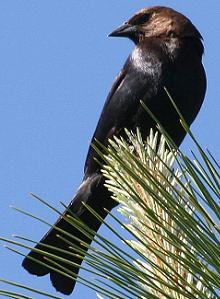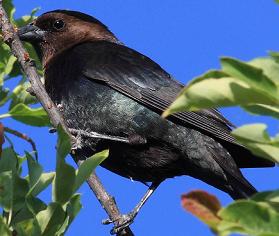Brown Headed Cowbird 
Identification and Pictures
(Molothrus ater)
Brown-headed cowbirds are stocky, glossy black
birds with brown heads, 6 to 8 inches. They have a short
tail, long pointed wings, and a thick head with a short conical
bill like fiches.
The females are brownish gray. The females may be
mistaken for Rusty blackbird females but the cowbird's bill is
much smaller. Juveniles are paler than females, and have
soft breast streaks. Young birds are often seen being
fed by smaller birds of another species.
Photos by Keith
Lee. The camera I use is the Canon
EOS 40D. Visit All-birds store

Brown-Headed Cowbird Sound
The male's song is a bubbly sound like
glug-glug-glee given while he leans forward in his dance.
While he sings the female will give a series of liquid
chatters. They have a flight call that sounds like
pee-see-see. Sound
Preferred Habitat
Brown-headed cowbirds can be found year-round
in the western U.S., and much of eastern U.S. Their summer range extends up into Canada.
They like riversides, wood edges, fields, pastures, and suburbs.
In winter, Brown-headed cowbirds may join large flocks with several blackbird species.
Breeding and Nesting
Males gather in small flocks to do courtship displays where they sing with their wings, and tail spread while fluffing their feathers to
attract females. The females will usually pick the dominant
male from the group.
The Mafia Bird
Cowbirds are brood parasites.
They do not build nests, and they do not take care of their
young. They lay their eggs in the nests of other
birds. Their eggs are white, light blue, or green with
red, brown, or purple speckles. Amazingly their strategy
is very successful, and the other birds often raise the young
cowbird as one of their own. It is believed cowbirds lay
their eggs in the nests of as many of 220 bird species.
Female cowbirds may lay as many as 40 eggs in a season.
The female will watch the activities of other birds to find
one building a nest. They prefer birds that are smaller
than themselves. When a nest is discovered she will
return to lay her egg. She will remove one of the host's
eggs from the nest in around 60 to 70 percent of the
time. Cowbird's eggs hatch sooner and grow faster than
many other birds giving the young cowbirds the advantage of
more food. They will often pitch the host bird's eggs,
and young out of the nest. Catbirds
are better than other birds at detecting and removing the
unwanted egg. Yellow Warblers
will often build a new nest over the top of the cowbird egg.
Cowbirds have been labeled Mafia Birds because recent studies
have shown that if a host bird removes the cowbird egg they routinely
come back and destroy the nest and eggs in it. It is
thought that this behavior results in the host birds learning
they are better off leaving the unwanted egg.
Food
Cowbirds eat seeds, grains, and insects.
They often forage on the ground. They got their name from
the habit of foraging for insects in herds of grazing animals.
They will often eat eggs removed from a nest they have laid an
egg in. They also eat snails, giving them the much
needed calcium they need to lay large numbers of eggs.
To learn about other favorite
birds click here.

|
